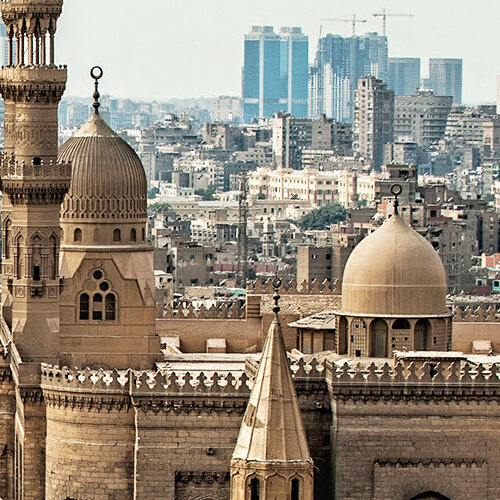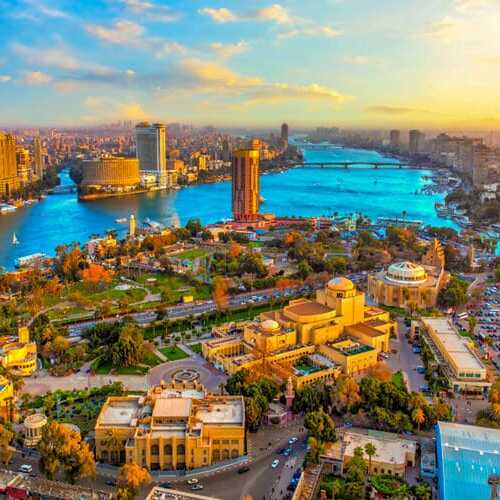No other nation in the world says ‘Welcome’ as often as the Egyptians, and every time, they mean it. While the ancient civilization of Egypt continues to amaze, contemporary Egyptians are equally remarkable.
Mosque-Madrassa of Sultan Hassan
The Mosque-Madrassa of Sultan Hassan: A Mamluk Masterpiece
Situated at Midan Salah ad-Din and constructed between 1356 and 1363, the Mosque-Madrassa of Sultan Hassan is a jewel of Mamluk architecture, celebrated as one of the most magnificent edifices of its time. The mosque’s foundation was laid under the reign of Sultan Qalaun, a ruler who ascended to power at the tender age of 13. His reign was marked by turbulence, with multiple overthrows and restorations, until his untimely assassination before the mosque’s completion.
The construction of the mosque itself is steeped in tragic history; a minaret collapse during its building claimed the lives of 300 onlookers. Despite this somber past, the mosque stands today as a testament to architectural grandeur. Its entrance, both attractive and intricately designed, leads to a corridor culminating in four domed halls, known as Iwans. Each Iwan is dedicated to one of the four major schools of Sunni Islam, symbolizing a confluence of Islamic scholarly traditions.
In the eastern Iwan lies an exquisitely crafted Mihrab, flanked by columns reportedly appropriated from the Crusaders. The Sultan’s private chambers are accessible through an ornate bronze door, adding to the mosque’s historical allure.
Adjacent to the Mosque-Madrassa of Sultan Hassan is another architectural marvel, the Mosque Ar-Rifai. Constructed over an extensive period from 1869 to 1912, it houses the tombs of notable figures such as Khedive Ismail, King Farouk, and other members of modern Egyptian royalty, including the last Shah of Iran. These final resting places, located to the left of the mosque’s entrance, offer a poignant reminder of Egypt’s rich and complex history.
The Mosque-Madrassa of Sultan Hassan is more than a religious site; it’s a historical narrative etched in stone, inviting visitors to step back in time and experience the grandeur of the Mamluk era.
Created On March 18, 2020
Updated On July 22 , 2025
CAIRO Travel Guide
- Al-Azhar Mosque
- Al-Azhar To The Citadel
- Amir Taz Palace
- Aqsunur’s Mosque
- Bab Zuweila
- Beit Al-Harrawi
- Beit Al-Suhaymi (Al-Suhaymi House)
- Beit Zeinab al-Khatoun
- Bein al-Qasreen STREET (Between The Two Palaces {Street})
- Ben Ezra Synagogue
- Church of St. Barbara
- Coptic Cairo
- Egyptian Textile Museum
- Gawhara Terrace
- Gayer-Anderson Museum
- Ibn Tulun Citadel
- Khan Al-Khalili Bazaar (Cairo’s Most Famous Bazaar)
- Khanqah & Mausoleum of Sultan Baybars al-Gashankir
- Khanqah-Mausoleum of Farag Ibn Barquq
- Madrassa & Mausoleum of as-Salih Ayyub
- Madrassa & Mausoleum of Qalawun
- An-Nasir Mohammed Bin Qalawoon Mosque
- Madrassa And Mausoleum of Barquq
- Mausoleum of Al-Ghouri
- Midan Al-Hussein (Sayedna Al-Hussein Square)
- Mosque of Al-Hakim
- Mosque of Al-Mu’ayyad Shaykh
- Mosque of al-Aqmar
- Mosque of Amr ibn al-As
- Mosque of An-Nasir Mohammed
- Mosque of Aslam al-Silahdar
- Mosque of Ibn Tulun
- Mosque of Mohammed Ali
- Mosque of Sayyidna al-Hussein
- Mosque-Madrassa of Al-Ghouri
- Mosque-Madrassa of Sultan Hassan
- Mosque-Madrassa of Umm Sultan Sha’aban
- Museo Mevlevi
- Museum of Islamic Art
- Northern Cemetery
- Northern Enclosure
- Northern Walls and Gates
- Sabil And Kuttab Of Abdel Rahman Katkhuda
- Sabil of Muhammed Ali Pasha
- Sharia al-Muizz li-Din Allah
- The Church of St Sergius & Bacchus
- The Citadel Of Saladin
- The Complex of Sultan Ashraf Barsbey
- The Coptic Museum (The Only Coptic Museum In Egypt)
- The Egyptian Museum
- The Hanging Church
- The Khayrbek Complex
- The Mosque of Sultan Qaitbey
- The Roman Towers
- Wikala al-Bazara
- Wikala of Al-Ghouri



